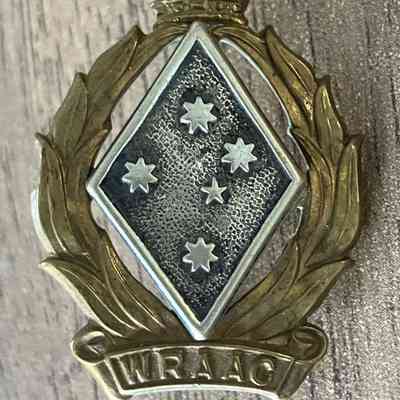WRAAC Cap Badge

2023.28.3
WRAAC Cap badge
Name/Title
WRAAC Cap BadgeEntry/Object ID
2023.28.3Description
Oval shaped brass badge with a laurel wreath around a diamond shaped silver shield, emblazoned with the southern cross. St Edward's crown surmounts the badge. A simple scroll on the bottom is embossed 'WRAAC'. Two brass lugs and lettering on rear [makers mark] K.C. LUKE MELB.Use
The WRAAC had its origins from the Australian Women’s Army Service (AWAS) which had been formed in 1941 to release men from some military duties to serve with fighting units. At the conclusion of WW2 the AWAS was disbanded in 1947. Due to concerns of the Korean War and for prepared readiness, approval was given for the raising of a women’s Corps, WAAC ( Women’s Australian Army Corps), in June 1950, within the Australian Military Forces. Later that year, an initial intake of 250 was approved, and in February 1951, Lt Col Kathleen Best was appointed as the first Director of the Corps. In June the same year, King George VI granted the addition of “Royal” to the Corps name in recognition of the wartime contributions or the women’s services and thus WRAAC came into being (Women’s Royal Australian Army Corps). Like the Second World War, the major aim of the corps, was to enlist women as replacements for men who had to undertake training and other duties required for war. The WRAACs worked in varied occupations, which included Cooks, Mess Stewardesses, Draftswomen, Clerks, Signal Operators, Drivers and Psychologists. Courses for trades and promotion in the NCO and Officer streams were taken as per our male counterparts. WRAAC was introduced into the Citizen Military Forces, for part time training, in December 1951 although recruitment did not start until June 1953. They were based in all States of Australia and a contingent of WRAAC Signal personnel was posted to Singapore for 12 months in 1967, during the the Vietnam War and later in the Malaysian conflict era. Integrated into the mainstream of the Military commenced in 1975, saw the current serving WRAAC personnel transferring or coming under the banner of male unit. The Women's Royal Australian Army Corps was disbanded in 1985, as women were permitted to enlist into the ADF (Australian Defence Force), and Service of choice. From the AWAS (Australian Women’s Army Service in WWII) to the WRAAC Company and now with the opportunities to serve in the recent areas of Bougainville, East Timor, Malaysia, Iraq and Afghanistan, the progression for female opportunities within the ADF, has been in line with that of the civilian world.Category
Personal Effects, War Memorabilia, Badge
